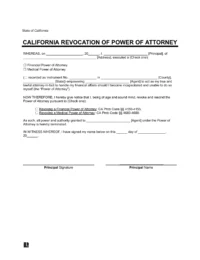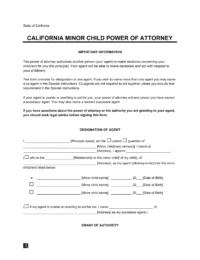A California durable statutory power of attorney form is a document that grants someone you choose (the “agent” or “attorney-in-fact”) the legal authority to act and make decisions for you (the “principal”).
Unlike a non-durable power of attorney, a durable one (DPOA) stays in effect even if the principal becomes incapacitated and unable to make their own decisions. This form is sometimes called a durable power of attorney for finances, and it’s used for financial and business matters. You need a medical power of attorney to grant durable power over health care decisions.
Laws
Power of attorney forms in the state can be made durable by including either the following statements or similar language:
“This power of attorney shall not be affected by subsequent incapacity of the principal.” / “This power of attorney shall become effective upon the incapacity of the principal.”
- Statute: California Probate Code, Division 4.5. Powers of Attorney.
- Presumed Durable: No (§ 4124).
- Signing Requirements: Requires date of execution and signature of the principal.
- Notarization: Must be acknowledged before a notary public or signed by at least two witnesses who are adults and are not the named attorney-in-fact (§ 4121).
- Statutory Form: Yes (§ 4401).
Definitions
Durable – The term “durable power of attorney” refers to a power of attorney that complies with the durability requirements established in Section 4124 (§ 4018).
Power of Attorney – The term “power of attorney” signifies a written document, regardless of its specific designation, executed by a natural person with the legal capacity to enter into contracts. This document grants authority to a designated representative, referred to as an attorney-in-fact. Powers of attorney can be classified as either durable or nondurable (§ 4022).
Specific Powers and Limitations
Restrictions on Gifts and Transfers
California Probate Code § 4264 provides some insights related to gifting within the context of trusts managed by an agent under a DPOA:
Types of Gifts:
- Funding existing trusts (not created by the principal): The agent can add assets to an existing trust, but only if it wasn’t created by the principal or someone authorized, potentially for beneficiaries designated within the DPOA.
- Making gifts in trust (if authorized): If the DPOA explicitly grants the agent this power, they can create new trusts involving the principal’s property and designate beneficiaries for those gifts within the trust structure.
Considerations:
- Preserving the principal’s financial security.
- Following the principal’s wishes or past gifting patterns (if known).
- Acting in the principal’s best interest, considering factors like the size of the estate, tax Implications, or government benefits eligibility.
Agent’s Authority Limitations
A DPOA may have specific limitations on the powers granted to the agent. Powers not expressly granted may be restricted, such as:
- The agent’s authority to engage in certain financial transactions or the limits on the amounts involved.
- Making gifts beyond a certain amount, changing beneficiary designations, or altering estate planning documents.
- Managing real estate or handling investments.
Revocation and Termination
A DPOA can be revoked in several ways by the principal at any time as long as they are mentally competent:
- Written revocation: This is the most common method. You can draft a written statement expressing your intent to revoke the form. It’s advisable to have the statement notarized for added proof.
- Destroying the DPOA: Physically destroying the original document is considered a valid revocation. However, it’s also recommended that the agent and any third parties (like banks) who have been informed about the form be notified to ensure everyone is aware of the revocation.
- Verbal revocation: California law recognizes verbal revocation, but it’s a less reliable method. Having written documentation is preferable to avoid any potential disputes about the revocation.
The agent’s authority can also end for reasons other than revocation by the principal:
- Principal’s death. However, in some circumstances, very specific powers might be authorized for the agent to act after death (check your document for details).
- Agent’s death or incapacity.
- Resignation of agent (Cal. Prob. Code § 4207).
Safekeeping and Registration
In California, there is no central, state-wide registry for durable powers of attorney, but you should store the original document in a secure location.
The most effective way to ensure your DPOA is recognized is to directly inform relevant parties about its existence. This includes providing a copy to your agent(s), financial institutions (banks, investment firms), your attorney (if you have one), and trusted individuals.
If you make any changes to your form, be sure to distribute new copies to all relevant parties and destroy any outdated versions. Additionally, ensure your successor agent, if named, is aware of their role and responsibilities.
How to Write
Here’s a step-by-step guide to help you write your own DPOA:
Step 1: Choose Your Agent
Select someone you trust implicitly to handle your affairs responsibly and in your best interests. Consider their trustworthiness, availability, and willingness.
Do they have a basic understanding of finances and managing property? You can also name a successor agent who takes over if your primary agent becomes unavailable.
Step 2: Decide on the Scope of Authority
Determine what powers you want to grant your agent (managing your finances, paying bills, investing).
Step 3: Fill Out the Form
Read the document thoroughly and understand each section before filling it out. Provide accurate and complete information about yourself, your agent(s), and the powers you are granting.
Pay close attention to details like the duration of the DPOA and any limitations on your agent’s authority.
Step 4: Sign the Document
State law requires your form to be signed by you and either witnessed by two adult witnesses who are not named as beneficiaries or notarized by a notary public.
Notarization is generally recommended as it adds an extra layer of verification and reduces the risk of challenges to the document’s validity.
Step 5: Distribute Copies and Keep the Original Safe
Provide a copy of the DPOA to your agent(s) and any other parties who may need to be aware of its existence;
Store the original securely, like a fireproof safe deposit box or a place at home.
Additional Resources
- State Bar Association: Information on the advantages of having a DPOA, such as avoiding probate and ensuring your affairs are managed according to your wishes.
- Franchise Tax Board: Provides an overview of POAs in the state, things to consider when creating one, and other valuable resources.
- California Advocates for Nursing Home Reform (CANHR): Focuses on how a durable power of attorney for property can help manage the affairs of someone in a nursing home.
Related Forms
Revocation of Power of Attorney
Signing Requirements: Notary public or at least two witnesses.
Medical Power of Attorney
Signing Requirements: Notary public or at least two witnesses.
Minor (Child) Power of Attorney
Signing Requirements: Notary public or two witnesses.



